Case Study on Nursing: Patient Care and Communication Techniques
VerifiedAdded on 2023/06/03
|8
|1722
|314
Case Study
AI Summary
This case study examines the case of Mrs. B, a patient with a complex medical history including major depression with psychosis and Alzheimer's type dementia, who was admitted with agitation, anxiety, delusions, and mood instability. The assignment addresses effective nursing communication techniques, including active listening, open-ended questions, and empathy, to facilitate engagement with patients. It delves into major depressive disorder with psychotic features, discussing mood-congruent and mood-incongruent psychotic characteristics. The study emphasizes the importance of communication in emotional wellness nursing, highlighting the need for nurses to develop therapeutic alliances and understand non-verbal cues. It also explores the impact of schizophrenia on eating habits and provides strategies for nurses to support eating disorder recovery. Furthermore, it touches upon the relationship between psychiatric disorders and sleep, discussing the management of insomnia. The case study underscores the multifaceted nature of patient care and the importance of tailored interventions.
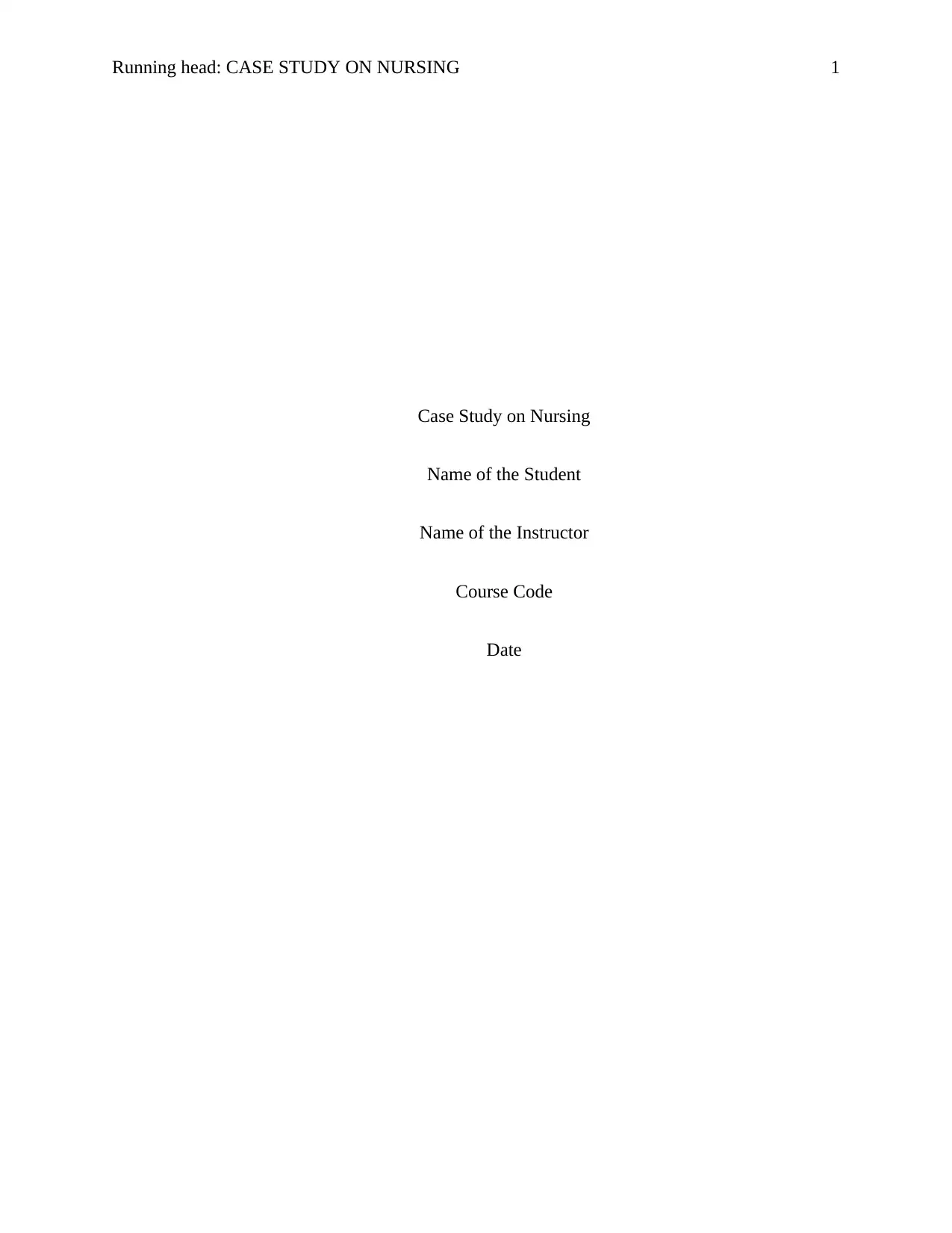
Running head: CASE STUDY ON NURSING 1
Case Study on Nursing
Name of the Student
Name of the Instructor
Course Code
Date
Case Study on Nursing
Name of the Student
Name of the Instructor
Course Code
Date
Paraphrase This Document
Need a fresh take? Get an instant paraphrase of this document with our AI Paraphraser
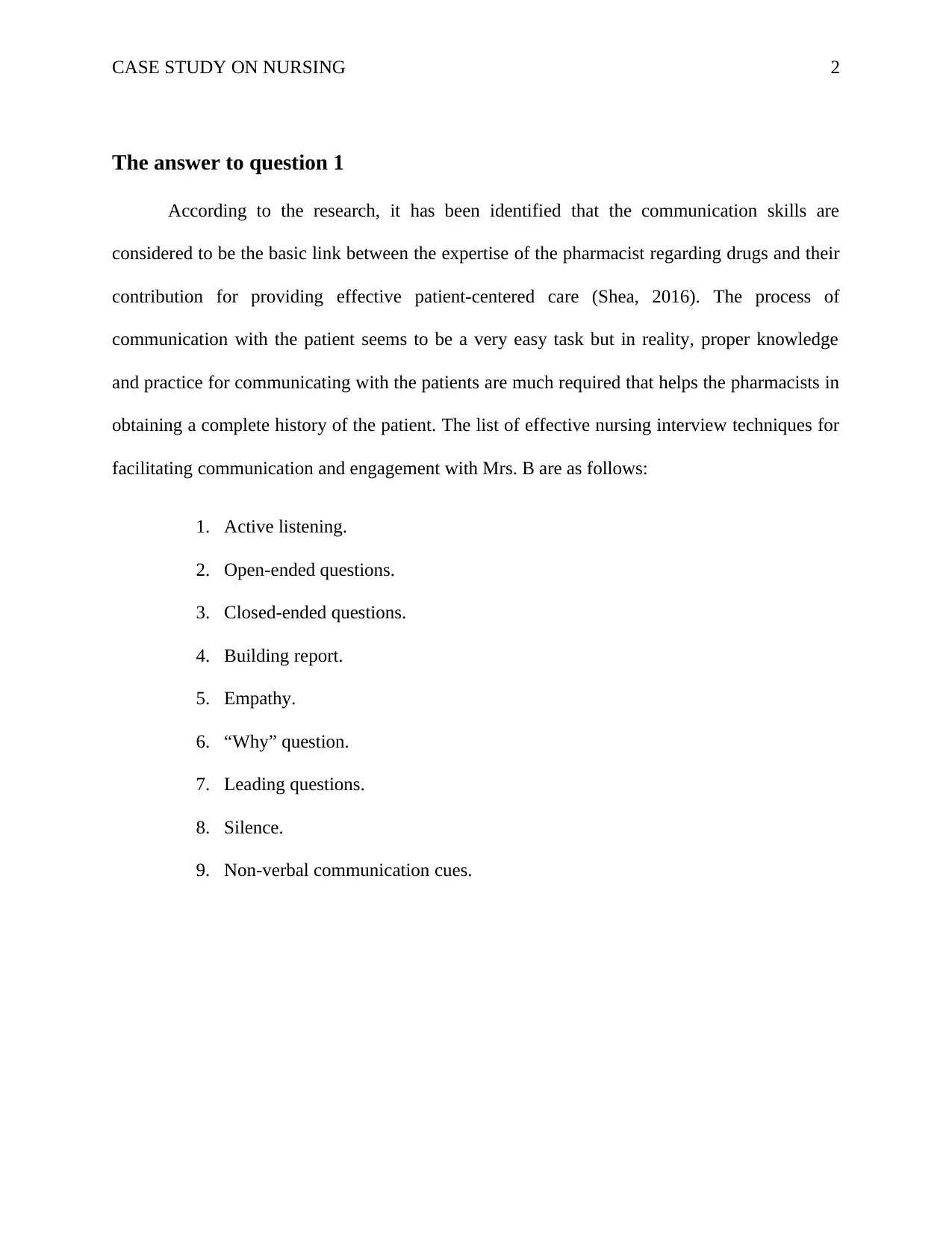
CASE STUDY ON NURSING 2
The answer to question 1
According to the research, it has been identified that the communication skills are
considered to be the basic link between the expertise of the pharmacist regarding drugs and their
contribution for providing effective patient-centered care (Shea, 2016). The process of
communication with the patient seems to be a very easy task but in reality, proper knowledge
and practice for communicating with the patients are much required that helps the pharmacists in
obtaining a complete history of the patient. The list of effective nursing interview techniques for
facilitating communication and engagement with Mrs. B are as follows:
1. Active listening.
2. Open-ended questions.
3. Closed-ended questions.
4. Building report.
5. Empathy.
6. “Why” question.
7. Leading questions.
8. Silence.
9. Non-verbal communication cues.
The answer to question 1
According to the research, it has been identified that the communication skills are
considered to be the basic link between the expertise of the pharmacist regarding drugs and their
contribution for providing effective patient-centered care (Shea, 2016). The process of
communication with the patient seems to be a very easy task but in reality, proper knowledge
and practice for communicating with the patients are much required that helps the pharmacists in
obtaining a complete history of the patient. The list of effective nursing interview techniques for
facilitating communication and engagement with Mrs. B are as follows:
1. Active listening.
2. Open-ended questions.
3. Closed-ended questions.
4. Building report.
5. Empathy.
6. “Why” question.
7. Leading questions.
8. Silence.
9. Non-verbal communication cues.
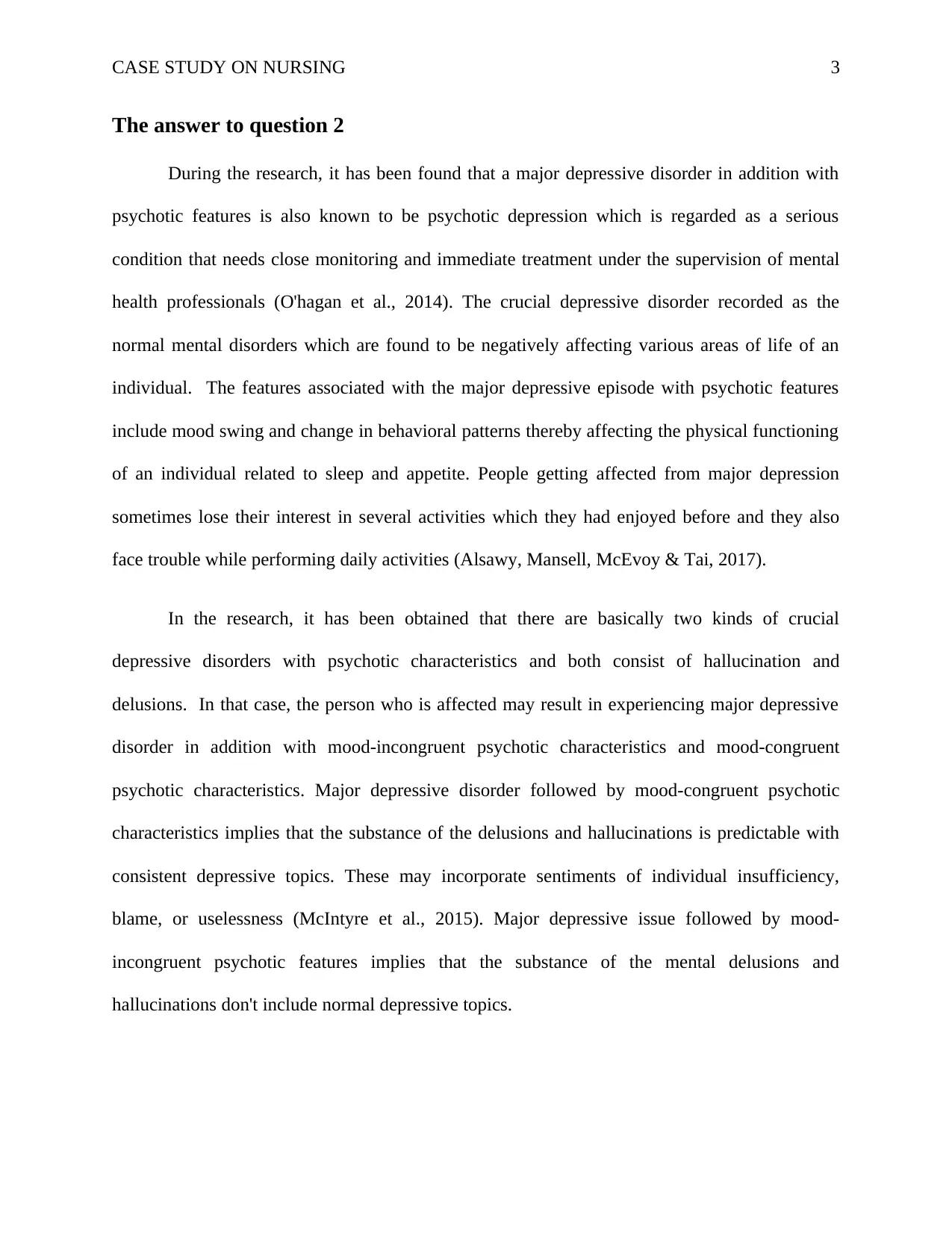
CASE STUDY ON NURSING 3
The answer to question 2
During the research, it has been found that a major depressive disorder in addition with
psychotic features is also known to be psychotic depression which is regarded as a serious
condition that needs close monitoring and immediate treatment under the supervision of mental
health professionals (O'hagan et al., 2014). The crucial depressive disorder recorded as the
normal mental disorders which are found to be negatively affecting various areas of life of an
individual. The features associated with the major depressive episode with psychotic features
include mood swing and change in behavioral patterns thereby affecting the physical functioning
of an individual related to sleep and appetite. People getting affected from major depression
sometimes lose their interest in several activities which they had enjoyed before and they also
face trouble while performing daily activities (Alsawy, Mansell, McEvoy & Tai, 2017).
In the research, it has been obtained that there are basically two kinds of crucial
depressive disorders with psychotic characteristics and both consist of hallucination and
delusions. In that case, the person who is affected may result in experiencing major depressive
disorder in addition with mood-incongruent psychotic characteristics and mood-congruent
psychotic characteristics. Major depressive disorder followed by mood-congruent psychotic
characteristics implies that the substance of the delusions and hallucinations is predictable with
consistent depressive topics. These may incorporate sentiments of individual insufficiency,
blame, or uselessness (McIntyre et al., 2015). Major depressive issue followed by mood-
incongruent psychotic features implies that the substance of the mental delusions and
hallucinations don't include normal depressive topics.
The answer to question 2
During the research, it has been found that a major depressive disorder in addition with
psychotic features is also known to be psychotic depression which is regarded as a serious
condition that needs close monitoring and immediate treatment under the supervision of mental
health professionals (O'hagan et al., 2014). The crucial depressive disorder recorded as the
normal mental disorders which are found to be negatively affecting various areas of life of an
individual. The features associated with the major depressive episode with psychotic features
include mood swing and change in behavioral patterns thereby affecting the physical functioning
of an individual related to sleep and appetite. People getting affected from major depression
sometimes lose their interest in several activities which they had enjoyed before and they also
face trouble while performing daily activities (Alsawy, Mansell, McEvoy & Tai, 2017).
In the research, it has been obtained that there are basically two kinds of crucial
depressive disorders with psychotic characteristics and both consist of hallucination and
delusions. In that case, the person who is affected may result in experiencing major depressive
disorder in addition with mood-incongruent psychotic characteristics and mood-congruent
psychotic characteristics. Major depressive disorder followed by mood-congruent psychotic
characteristics implies that the substance of the delusions and hallucinations is predictable with
consistent depressive topics. These may incorporate sentiments of individual insufficiency,
blame, or uselessness (McIntyre et al., 2015). Major depressive issue followed by mood-
incongruent psychotic features implies that the substance of the mental delusions and
hallucinations don't include normal depressive topics.
⊘ This is a preview!⊘
Do you want full access?
Subscribe today to unlock all pages.

Trusted by 1+ million students worldwide
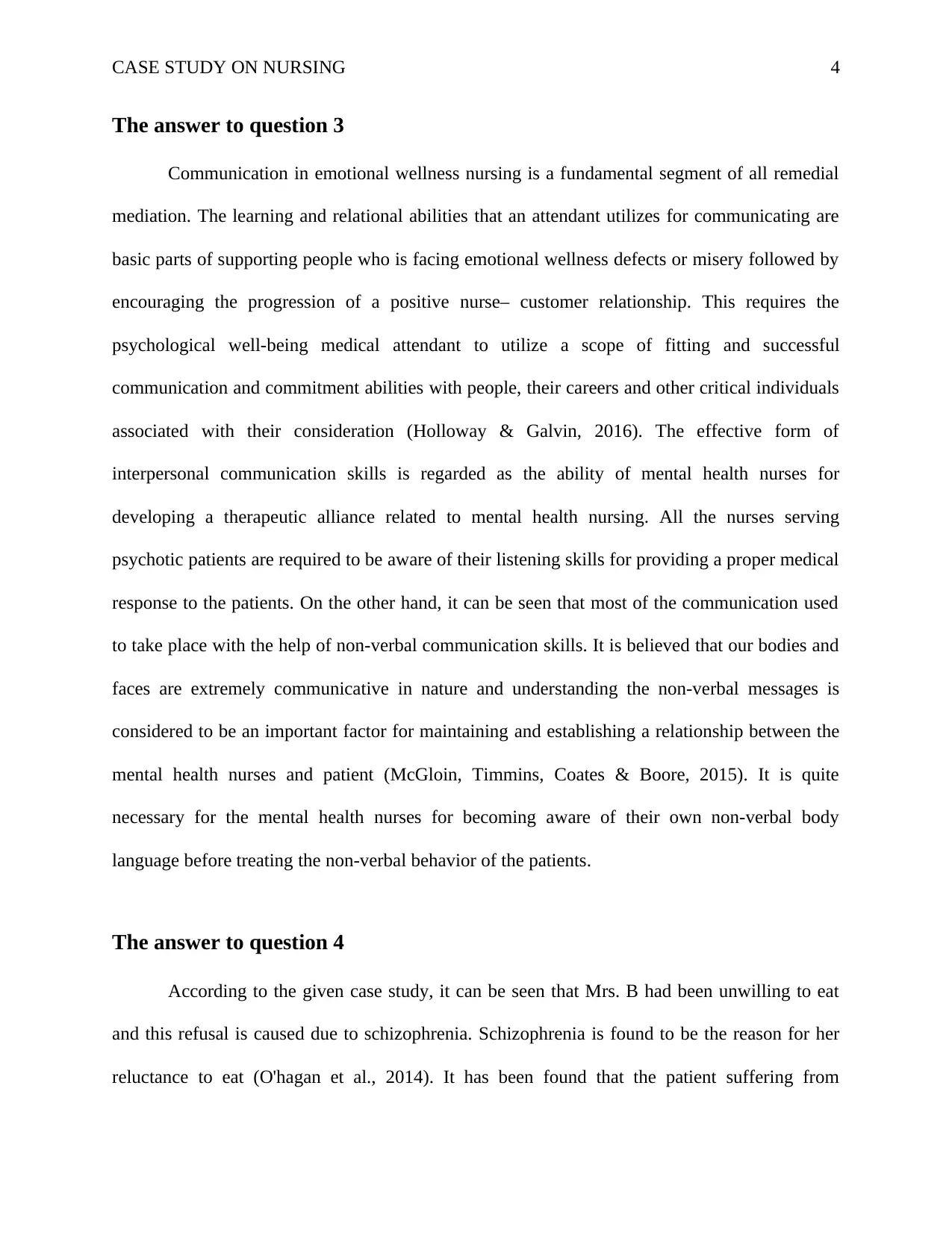
CASE STUDY ON NURSING 4
The answer to question 3
Communication in emotional wellness nursing is a fundamental segment of all remedial
mediation. The learning and relational abilities that an attendant utilizes for communicating are
basic parts of supporting people who is facing emotional wellness defects or misery followed by
encouraging the progression of a positive nurse– customer relationship. This requires the
psychological well-being medical attendant to utilize a scope of fitting and successful
communication and commitment abilities with people, their careers and other critical individuals
associated with their consideration (Holloway & Galvin, 2016). The effective form of
interpersonal communication skills is regarded as the ability of mental health nurses for
developing a therapeutic alliance related to mental health nursing. All the nurses serving
psychotic patients are required to be aware of their listening skills for providing a proper medical
response to the patients. On the other hand, it can be seen that most of the communication used
to take place with the help of non-verbal communication skills. It is believed that our bodies and
faces are extremely communicative in nature and understanding the non-verbal messages is
considered to be an important factor for maintaining and establishing a relationship between the
mental health nurses and patient (McGloin, Timmins, Coates & Boore, 2015). It is quite
necessary for the mental health nurses for becoming aware of their own non-verbal body
language before treating the non-verbal behavior of the patients.
The answer to question 4
According to the given case study, it can be seen that Mrs. B had been unwilling to eat
and this refusal is caused due to schizophrenia. Schizophrenia is found to be the reason for her
reluctance to eat (O'hagan et al., 2014). It has been found that the patient suffering from
The answer to question 3
Communication in emotional wellness nursing is a fundamental segment of all remedial
mediation. The learning and relational abilities that an attendant utilizes for communicating are
basic parts of supporting people who is facing emotional wellness defects or misery followed by
encouraging the progression of a positive nurse– customer relationship. This requires the
psychological well-being medical attendant to utilize a scope of fitting and successful
communication and commitment abilities with people, their careers and other critical individuals
associated with their consideration (Holloway & Galvin, 2016). The effective form of
interpersonal communication skills is regarded as the ability of mental health nurses for
developing a therapeutic alliance related to mental health nursing. All the nurses serving
psychotic patients are required to be aware of their listening skills for providing a proper medical
response to the patients. On the other hand, it can be seen that most of the communication used
to take place with the help of non-verbal communication skills. It is believed that our bodies and
faces are extremely communicative in nature and understanding the non-verbal messages is
considered to be an important factor for maintaining and establishing a relationship between the
mental health nurses and patient (McGloin, Timmins, Coates & Boore, 2015). It is quite
necessary for the mental health nurses for becoming aware of their own non-verbal body
language before treating the non-verbal behavior of the patients.
The answer to question 4
According to the given case study, it can be seen that Mrs. B had been unwilling to eat
and this refusal is caused due to schizophrenia. Schizophrenia is found to be the reason for her
reluctance to eat (O'hagan et al., 2014). It has been found that the patient suffering from
Paraphrase This Document
Need a fresh take? Get an instant paraphrase of this document with our AI Paraphraser

CASE STUDY ON NURSING 5
schizophrenia may encounter several kinds of disturbances related to eating habits which result
in the formation of overall eating disorders.
During the research it has been found that there are various kinds of critical ways with the
help of which nurses can help in supporting the eating disorder recovery which is as follows:
1. Nurses support in managing the medications of the patients.
2. Nurses have the capability in answering any pertinent medical queries related to eating
habits.
3. Nurses have the capability of providing coordinate care in combination with the
outpatient medical providers.
4. Nurses have the capability of lending an ear for understanding the eating disorders of the
patients (McIntyre, et al., 2015).
5. Nurses price to maintain African communication with the mediation team for providing
effective medical support to recover the health conditions of the patient with eating
disorders.
The answer to question 5
During the research, it has been found that psychiatric disorder and rest are connected in
vital ways (Ackley, Ladwig & Makic, 2016). Reliable with this perspective is that rest issues are
characterizing highlights of various mental scatters and included among the symptomatic criteria
for these conditions. However, there are some the extra ways that mental disarranges and rest is
between related (Kempler, Sharpe, Miller & Bartlett, 2016).
schizophrenia may encounter several kinds of disturbances related to eating habits which result
in the formation of overall eating disorders.
During the research it has been found that there are various kinds of critical ways with the
help of which nurses can help in supporting the eating disorder recovery which is as follows:
1. Nurses support in managing the medications of the patients.
2. Nurses have the capability in answering any pertinent medical queries related to eating
habits.
3. Nurses have the capability of providing coordinate care in combination with the
outpatient medical providers.
4. Nurses have the capability of lending an ear for understanding the eating disorders of the
patients (McIntyre, et al., 2015).
5. Nurses price to maintain African communication with the mediation team for providing
effective medical support to recover the health conditions of the patient with eating
disorders.
The answer to question 5
During the research, it has been found that psychiatric disorder and rest are connected in
vital ways (Ackley, Ladwig & Makic, 2016). Reliable with this perspective is that rest issues are
characterizing highlights of various mental scatters and included among the symptomatic criteria
for these conditions. However, there are some the extra ways that mental disarranges and rest is
between related (Kempler, Sharpe, Miller & Bartlett, 2016).
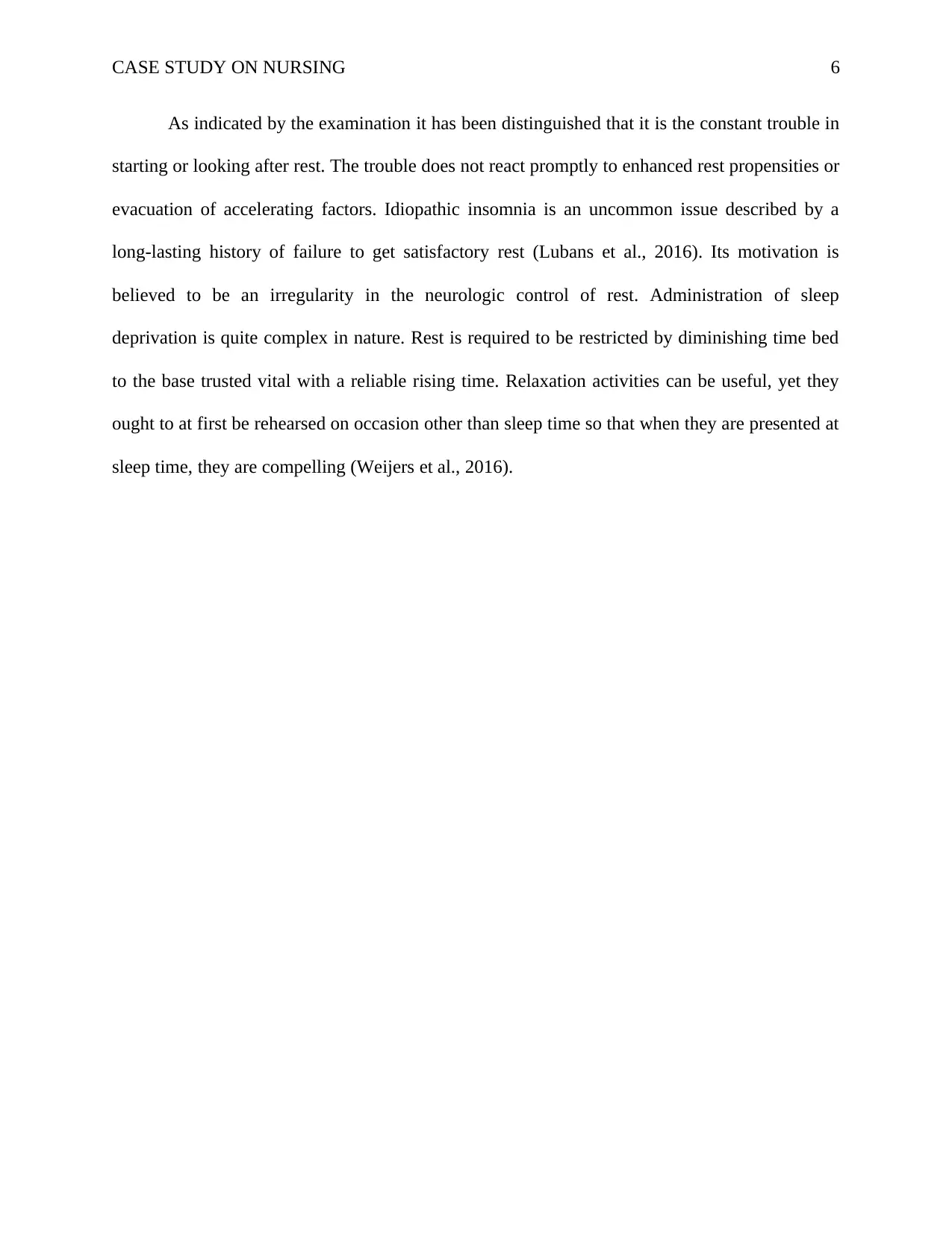
CASE STUDY ON NURSING 6
As indicated by the examination it has been distinguished that it is the constant trouble in
starting or looking after rest. The trouble does not react promptly to enhanced rest propensities or
evacuation of accelerating factors. Idiopathic insomnia is an uncommon issue described by a
long-lasting history of failure to get satisfactory rest (Lubans et al., 2016). Its motivation is
believed to be an irregularity in the neurologic control of rest. Administration of sleep
deprivation is quite complex in nature. Rest is required to be restricted by diminishing time bed
to the base trusted vital with a reliable rising time. Relaxation activities can be useful, yet they
ought to at first be rehearsed on occasion other than sleep time so that when they are presented at
sleep time, they are compelling (Weijers et al., 2016).
As indicated by the examination it has been distinguished that it is the constant trouble in
starting or looking after rest. The trouble does not react promptly to enhanced rest propensities or
evacuation of accelerating factors. Idiopathic insomnia is an uncommon issue described by a
long-lasting history of failure to get satisfactory rest (Lubans et al., 2016). Its motivation is
believed to be an irregularity in the neurologic control of rest. Administration of sleep
deprivation is quite complex in nature. Rest is required to be restricted by diminishing time bed
to the base trusted vital with a reliable rising time. Relaxation activities can be useful, yet they
ought to at first be rehearsed on occasion other than sleep time so that when they are presented at
sleep time, they are compelling (Weijers et al., 2016).
⊘ This is a preview!⊘
Do you want full access?
Subscribe today to unlock all pages.

Trusted by 1+ million students worldwide
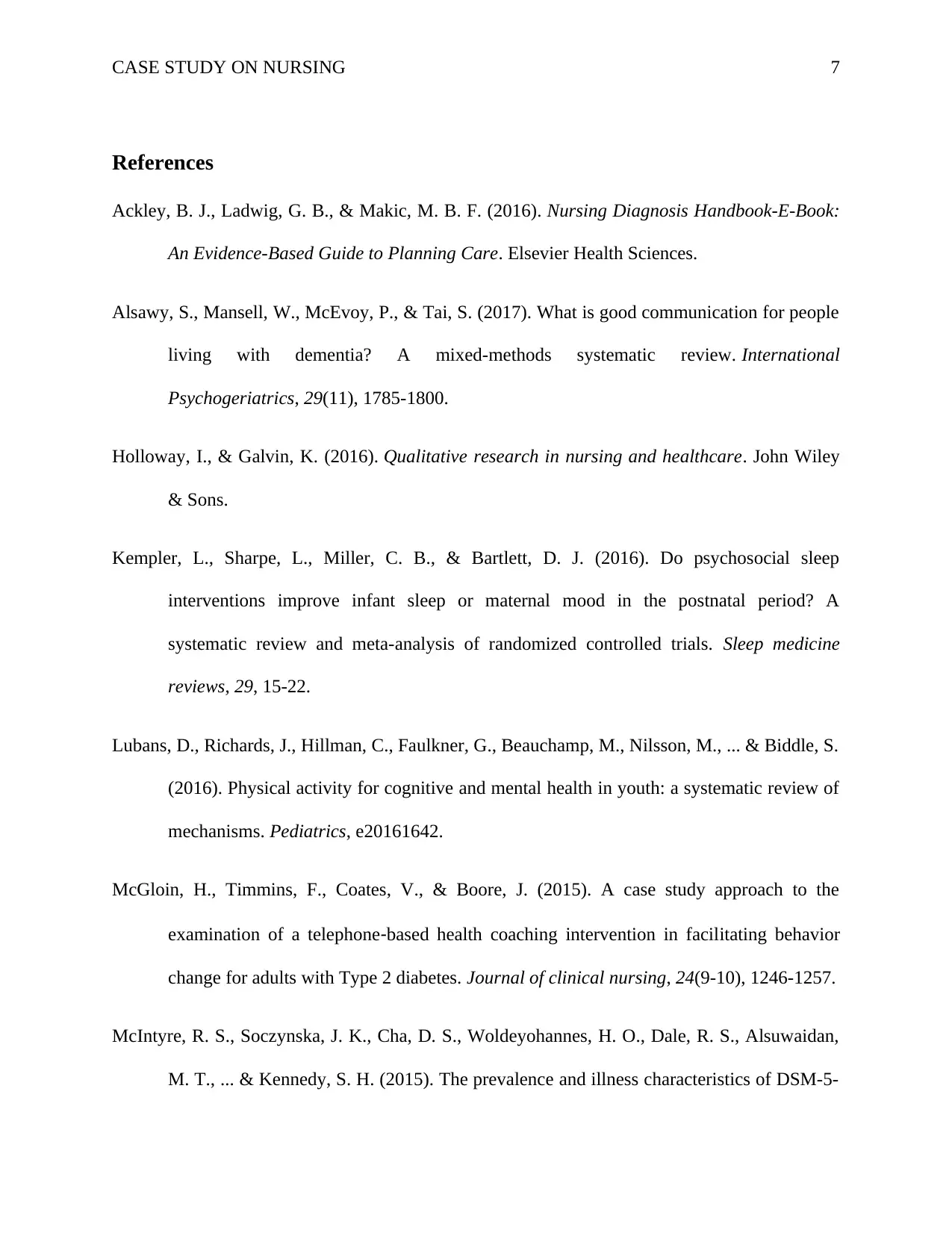
CASE STUDY ON NURSING 7
References
Ackley, B. J., Ladwig, G. B., & Makic, M. B. F. (2016). Nursing Diagnosis Handbook-E-Book:
An Evidence-Based Guide to Planning Care. Elsevier Health Sciences.
Alsawy, S., Mansell, W., McEvoy, P., & Tai, S. (2017). What is good communication for people
living with dementia? A mixed-methods systematic review. International
Psychogeriatrics, 29(11), 1785-1800.
Holloway, I., & Galvin, K. (2016). Qualitative research in nursing and healthcare. John Wiley
& Sons.
Kempler, L., Sharpe, L., Miller, C. B., & Bartlett, D. J. (2016). Do psychosocial sleep
interventions improve infant sleep or maternal mood in the postnatal period? A
systematic review and meta-analysis of randomized controlled trials. Sleep medicine
reviews, 29, 15-22.
Lubans, D., Richards, J., Hillman, C., Faulkner, G., Beauchamp, M., Nilsson, M., ... & Biddle, S.
(2016). Physical activity for cognitive and mental health in youth: a systematic review of
mechanisms. Pediatrics, e20161642.
McGloin, H., Timmins, F., Coates, V., & Boore, J. (2015). A case study approach to the
examination of a telephone‐based health coaching intervention in facilitating behavior
change for adults with Type 2 diabetes. Journal of clinical nursing, 24(9-10), 1246-1257.
McIntyre, R. S., Soczynska, J. K., Cha, D. S., Woldeyohannes, H. O., Dale, R. S., Alsuwaidan,
M. T., ... & Kennedy, S. H. (2015). The prevalence and illness characteristics of DSM-5-
References
Ackley, B. J., Ladwig, G. B., & Makic, M. B. F. (2016). Nursing Diagnosis Handbook-E-Book:
An Evidence-Based Guide to Planning Care. Elsevier Health Sciences.
Alsawy, S., Mansell, W., McEvoy, P., & Tai, S. (2017). What is good communication for people
living with dementia? A mixed-methods systematic review. International
Psychogeriatrics, 29(11), 1785-1800.
Holloway, I., & Galvin, K. (2016). Qualitative research in nursing and healthcare. John Wiley
& Sons.
Kempler, L., Sharpe, L., Miller, C. B., & Bartlett, D. J. (2016). Do psychosocial sleep
interventions improve infant sleep or maternal mood in the postnatal period? A
systematic review and meta-analysis of randomized controlled trials. Sleep medicine
reviews, 29, 15-22.
Lubans, D., Richards, J., Hillman, C., Faulkner, G., Beauchamp, M., Nilsson, M., ... & Biddle, S.
(2016). Physical activity for cognitive and mental health in youth: a systematic review of
mechanisms. Pediatrics, e20161642.
McGloin, H., Timmins, F., Coates, V., & Boore, J. (2015). A case study approach to the
examination of a telephone‐based health coaching intervention in facilitating behavior
change for adults with Type 2 diabetes. Journal of clinical nursing, 24(9-10), 1246-1257.
McIntyre, R. S., Soczynska, J. K., Cha, D. S., Woldeyohannes, H. O., Dale, R. S., Alsuwaidan,
M. T., ... & Kennedy, S. H. (2015). The prevalence and illness characteristics of DSM-5-
Paraphrase This Document
Need a fresh take? Get an instant paraphrase of this document with our AI Paraphraser
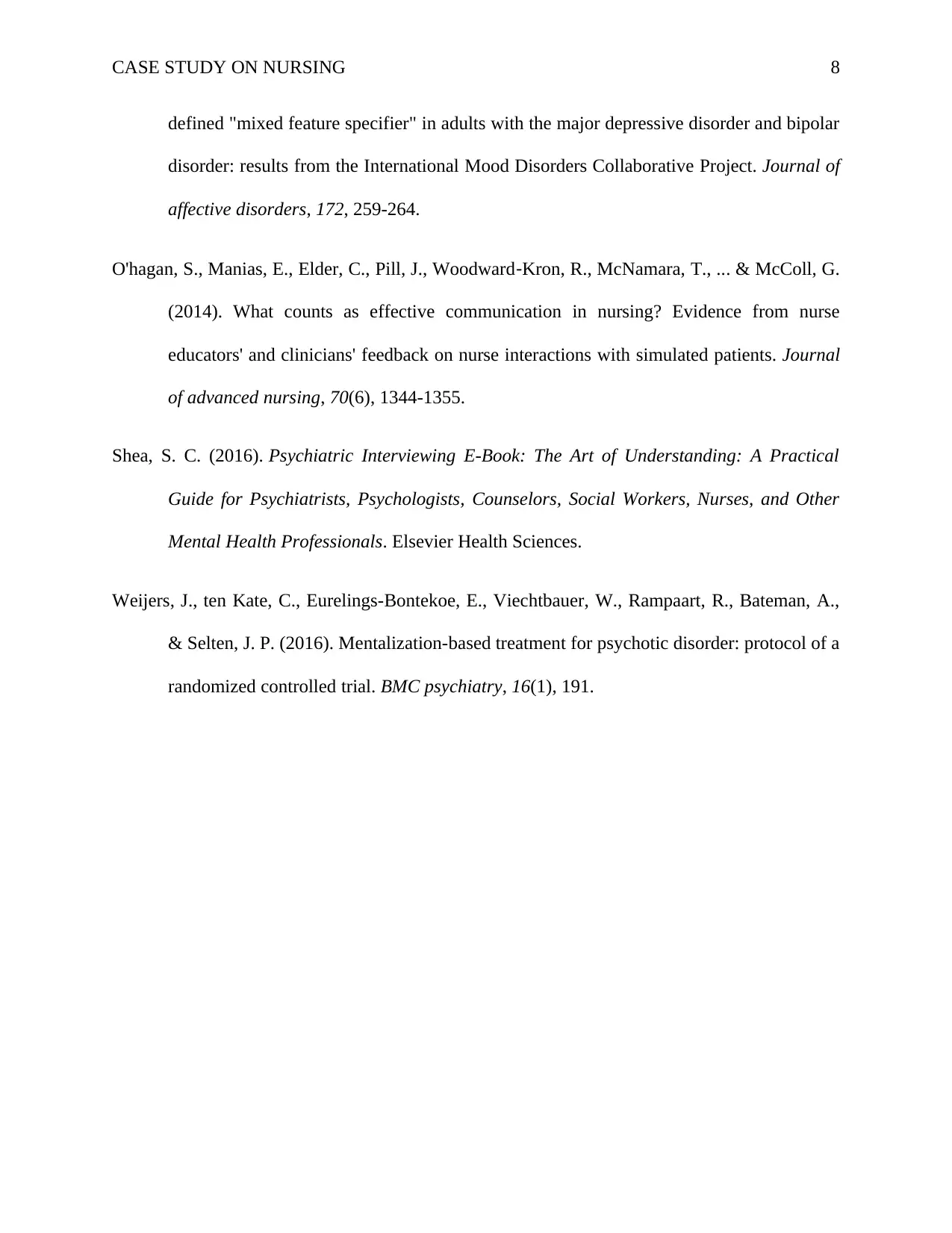
CASE STUDY ON NURSING 8
defined "mixed feature specifier" in adults with the major depressive disorder and bipolar
disorder: results from the International Mood Disorders Collaborative Project. Journal of
affective disorders, 172, 259-264.
O'hagan, S., Manias, E., Elder, C., Pill, J., Woodward‐Kron, R., McNamara, T., ... & McColl, G.
(2014). What counts as effective communication in nursing? Evidence from nurse
educators' and clinicians' feedback on nurse interactions with simulated patients. Journal
of advanced nursing, 70(6), 1344-1355.
Shea, S. C. (2016). Psychiatric Interviewing E-Book: The Art of Understanding: A Practical
Guide for Psychiatrists, Psychologists, Counselors, Social Workers, Nurses, and Other
Mental Health Professionals. Elsevier Health Sciences.
Weijers, J., ten Kate, C., Eurelings-Bontekoe, E., Viechtbauer, W., Rampaart, R., Bateman, A.,
& Selten, J. P. (2016). Mentalization-based treatment for psychotic disorder: protocol of a
randomized controlled trial. BMC psychiatry, 16(1), 191.
defined "mixed feature specifier" in adults with the major depressive disorder and bipolar
disorder: results from the International Mood Disorders Collaborative Project. Journal of
affective disorders, 172, 259-264.
O'hagan, S., Manias, E., Elder, C., Pill, J., Woodward‐Kron, R., McNamara, T., ... & McColl, G.
(2014). What counts as effective communication in nursing? Evidence from nurse
educators' and clinicians' feedback on nurse interactions with simulated patients. Journal
of advanced nursing, 70(6), 1344-1355.
Shea, S. C. (2016). Psychiatric Interviewing E-Book: The Art of Understanding: A Practical
Guide for Psychiatrists, Psychologists, Counselors, Social Workers, Nurses, and Other
Mental Health Professionals. Elsevier Health Sciences.
Weijers, J., ten Kate, C., Eurelings-Bontekoe, E., Viechtbauer, W., Rampaart, R., Bateman, A.,
& Selten, J. P. (2016). Mentalization-based treatment for psychotic disorder: protocol of a
randomized controlled trial. BMC psychiatry, 16(1), 191.
1 out of 8
Related Documents
Your All-in-One AI-Powered Toolkit for Academic Success.
+13062052269
info@desklib.com
Available 24*7 on WhatsApp / Email
![[object Object]](/_next/static/media/star-bottom.7253800d.svg)
Unlock your academic potential
Copyright © 2020–2025 A2Z Services. All Rights Reserved. Developed and managed by ZUCOL.





